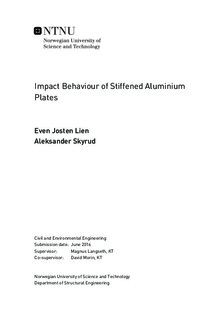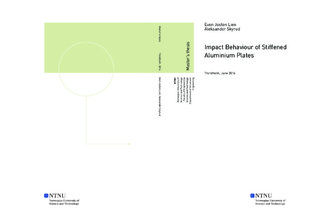| dc.description.abstract | In this master thesis stiffened aluminium plates of the aluminium alloy AA6082 subjected to impact loading was studied. The main objective was to study the behaviour of welded and stiffened aluminium plates exposed to impact loading from a ship, and determine how to model this in a large scale analysis. This master thesis was initiated in a cooperation between CASA at NTNU, Hydro Aluminium and SAPA, as a part of the project Ferry-free coastal route E39 . This project is a continuation of the master thesis that Bente Larsen Kårstad and Birgitte Skajaa wrote in 2015.
It was planned to conduct both material tests and quasi-static impact tests of the stiffened aluminium plates in the laboratory as part of this report. Due to problems in the production line, the components never arrived on time. After a discussion with our supervisors in mid-May, the laboratory tests were cancelled and it was decided to focus on the establishment and validation of numerical models to replicate the experiments that Hilde Giæver Hildrum carried through in her Dr.Ing- thesis, and to do a preliminary analysis of a different test setup with both T4- and T6-plates. A literature study on the behaviour and modelling of stiffened aluminium plates subjected to impact loading has also been conducted.
As a part of this thesis a numerical model in the finite element software Abaqus has been established in order to replicate the static tests that Hildrum carried through. The numerical models give acceptable estimations and captures the failure modes for all of the different test setups in a satisfactorily way. However, there are some aberrations in predictions of failure and the stiffness of the plate. The material model was simplified by implementing the isotropic von Mises yield criterion, in which case the great degree of anisotropy in the AA6082-T6 alloy is neglected. It was also decided to model the plate without a weld. This could explain some of the varying accuracy in the numerical simulations.
The numerical model in the preliminary analysis was conducted with two different heat treatments of the AA6082 alloy, namely T4 and T6. The difference between the behaviour of the plate with the two alloys is large, since different heat treatments yields different material properties and behaviour. For both the T4- and T6-plate, two different fracture criterions has been implemented, the Cockcroft-Latham (CL) fracture criterion and
the Bressan-Williams-Hill (BWH) instability criterion. The numerical simulations show difference in both initiations of fracture and failure modes for the two criterions. Analyses run with BWH yields a better coherence between different mesh sizes than CL, and is also less computational expensive, which makes it more favourable in large scale analysis. | en |

